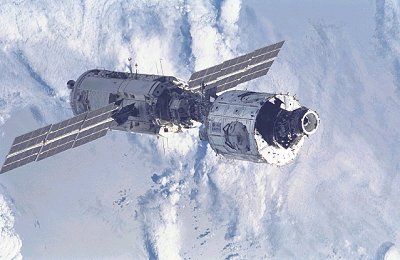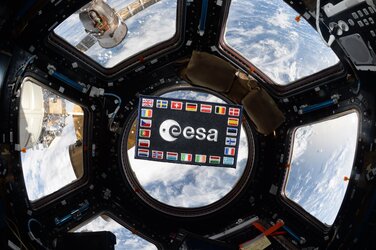Building the International Space Station
The International Space Station weighs almost 400 tonnes and covers an area as big as a football pitch. It would have been impossible to build the Space Station on Earth and then launch it into space in one go - there is no rocket big enough or powerful enough. To get round this problem the Space Station was taken into space piece-by-piece and gradually built in orbit, approximately 400 km above the Earth's surface. This assembly required more than 40 missions.
A partnership between European countries (represented by ESA), the United States (NASA), Japan (JAXA), Canada (CSA) and Russia (Roscosmos), the International Space Station is the world's largest international cooperative programme in science and technology.
In the following list the Space Station assembly flights are coded with a number and a letter: A stands for America, R for Russian, E for European and J for Japanese. UL is 'Utilisation Flight', LF means 'Logistics Flight' and ULF is an abbreviation from 'Utilisation and Logistics Flight'.

1998
1 A/R
20 November: The ‘Zarya’ Control Module, Russian Proton rocket
2A
4 December: The ‘Unity’ Node with two pressurized mating adapters, Space Shuttle Endeavour (STS-88)
1999
2A.1
27 May: Logistics and supplies, Space Shuttle Discovery (STS-96)

2000
2A.2a
19 May 19: Preparations for the ‘Zvezda’ Service Module, Space Shuttle Atlantis (STS-101)
1R
12 July: The Zvezda Service Module, Russian Proton rocket
2A.2b
8 September: Logistics and supplies, Space Shuttle Atlantis (STS-106)
3A
11 October: The Z1-Truss, a 3rd pressurized mating adapter and a Ku-band antenna, Space Shuttle Discovery (STS-92)
2R
30 October: The first Expedition crew launched aboard a Soyuz spacecraft
4A
30 November: The P-6 Truss, Space Shuttle Endeavour (STS-97)

2001
5A
7 February: ‘Destiny’ Laboratory Module, Space Shuttle Atlantis (STS-98)
5A.1
8 March: Logistics and supplies with Leonardo Multi-Purpose Logistics Module, Space Shuttle Discovery (STS-102)
6A
19 April: Racks to the Destiny Laboratory with the Raffaello MPLM and Canaradm2, Space Shuttle Endeavour (STS-100)
7A
12 July: Joint Airlock, Space Shuttle Atlantis (STS-104)
7A.1
10 August: Logistics and supplies, crew exhange, Space Shuttle Discovery (STS-105)
4R
14 September: ‘Pirs’ Docking Compartment, Russian Soyuz rocket
UF-1
5 December: Racks to the Destiny Laboratory with the Raffaello MPLM, Space Shuttle Endeavour (STS-108)

2002
UF-2
5 June: Payload and experiment racks to the Destiny Laboratory with the Leonardo MPLM and Mobile Base System for the Station's Mobile Servicing System, Space Shuttle Endeavour (STS-111)
8A
8 April: S0-Truss and the Mobile Transporter, Space Shuttle Atlantis (STS-110)
9A
7 October: First starboard truss segment (S1), Space Shuttle Atlantis (STS-112)
11A
23 November: First port truss segment (P1), P6 solar arrays deployed and activated, Space Shuttle Endeavour (STS-113)
2005
LF 1
26 July: Supplies and equipment with the Raffaello MPLM, Space Shuttle Discovery (STS-114, Shuttle's Return to Flight mission after Columbia accident)

2006
ULF 1.1
4 July: Supplies and equipment with the Leonardo MPLM, Space Shuttle Discovery (STS-121). ESA astronaut Thomas Reiter as Expedition 13 crewmember.
12A
9 September: Second and third starboard truss segments (P3/P4), pair of solar arrays and radiator, Space Shuttle Atlantis (STS-115)
12A.1
9 December: Third port truss segment (P5), logistics and supplies with a SPACEHAB cargo module, Space Shuttle Discovery (STS-116)

2007
13A
8 June: Second and third starboard truss segments (S3/S4), pair of solar arrays, Space Shuttle Atlantis (STS-117)
13A.1
8 August: Third starboard truss segment (S5), supplies and equipment with a SPACEHAB cargo module, Space Shuttle Endeavour (STS-118)
10A
23 October: The European-made Node-2 Harmony module (for attaching the European Columbus laboratory and the Japanese Kibo laboratory), Space Shuttle Discovery (STS-120)

2008
1E
7 February: ESA’s Columbus laboratory, Space Shuttle Atlantis (STS-122)
1J/A
11 March: First pressurized component of the Japanese Kibo laboratory, Space Shuttle Endeavour (STS-123)
1J
31 May: Second pressurized module and robotic arm of the Japanese Kibo laboratory, Space Shuttle Discovery (STS-124)
ULF2
14 November: Supplies, equipment and spares with the Leonardo MPLM, Space Shuttle Endeavour (STS-126)

2009
15A
15 March: Final starboard truss segment (S6) and final solar array pair, Space Shuttle Discovery (STS-119)
2J/A
15 July: Experiment Module Exposed Facility and Experiment Logistics Module Exposed Section for the Japanese Kibo laboratory, Space Shuttle Endeavour (STS-127)
17A
28 August: Life support and science racks with the Leonardo MPLM, Space Shuttle Discovery (STS-128)
5R
12 November: The Russian Mini-Research Module-2 (MRM2), launched by Soyuz rocket from the Baikonur Cosmodrome on 10 November
 ULF3
ULF3
16 November: Supplies and spares, Space Shuttle Atlantis (STS-129)
2010
20A
8 February: Node-3 ‘Tranquility’ and Cupola, Space Shuttle Endeavour (STS-130)
19A
5 April: Supplies and science racks with the Leonardo MPLM, Space Shuttle Discovery (STS-131)
ULF4
14 May: Integrated Cargo Carrier and the Russian-built Mini-Research Module-1, Space Shuttle Atlantis (STS-132)
 2011
2011
ULF5
24 February: Permanent Multipurpose Module Leonardo and Robonaut 2, Space Shuttle Discovery (STS-133)
ULF6
16 May: AMS-02 and supplies, Space Shuttle Endeavour (STS-134)
ULF7
16 May: Supplies, equipment and spares with the Raffaello MPLM, Space Shuttle Atlantis (STS-135)
2016
BEAM
15 April: Bigelow Expandable Activity Module installed to Node-3 port, SpaceX Dragon CRS-8
2021
CRS-22
3 June: ISS Roll Out Solar Array (iROSA), SpaceX Cargo Draon.
R3
21 July: Nauka, Multipurpose Laboratory Module with European Robotic Arm (ERA), Russian Proton-M rocket.











